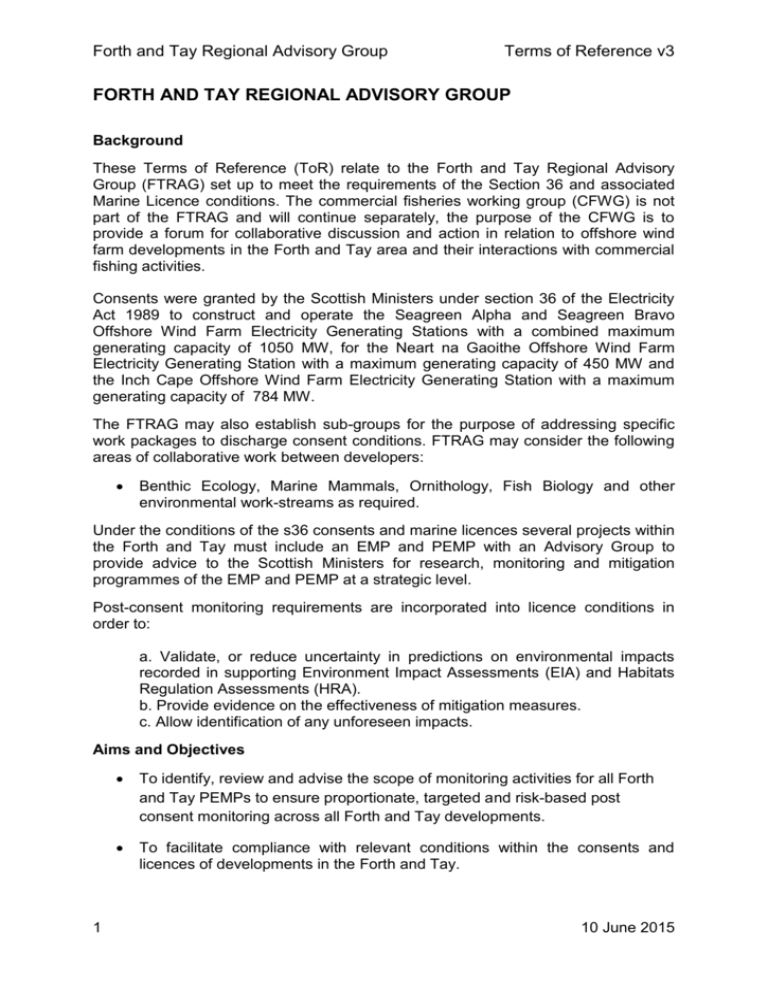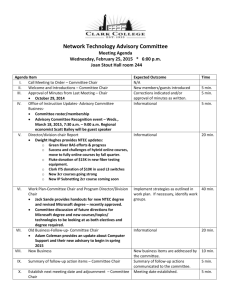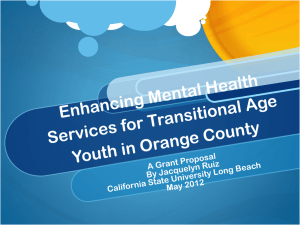SCOTTISH TERRITORIAL WATERS OFFSHORE WIND
advertisement

Forth and Tay Regional Advisory Group Terms of Reference v3 FORTH AND TAY REGIONAL ADVISORY GROUP Background These Terms of Reference (ToR) relate to the Forth and Tay Regional Advisory Group (FTRAG) set up to meet the requirements of the Section 36 and associated Marine Licence conditions. The commercial fisheries working group (CFWG) is not part of the FTRAG and will continue separately, the purpose of the CFWG is to provide a forum for collaborative discussion and action in relation to offshore wind farm developments in the Forth and Tay area and their interactions with commercial fishing activities. Consents were granted by the Scottish Ministers under section 36 of the Electricity Act 1989 to construct and operate the Seagreen Alpha and Seagreen Bravo Offshore Wind Farm Electricity Generating Stations with a combined maximum generating capacity of 1050 MW, for the Neart na Gaoithe Offshore Wind Farm Electricity Generating Station with a maximum generating capacity of 450 MW and the Inch Cape Offshore Wind Farm Electricity Generating Station with a maximum generating capacity of 784 MW. The FTRAG may also establish sub-groups for the purpose of addressing specific work packages to discharge consent conditions. FTRAG may consider the following areas of collaborative work between developers: Benthic Ecology, Marine Mammals, Ornithology, Fish Biology and other environmental work-streams as required. Under the conditions of the s36 consents and marine licences several projects within the Forth and Tay must include an EMP and PEMP with an Advisory Group to provide advice to the Scottish Ministers for research, monitoring and mitigation programmes of the EMP and PEMP at a strategic level. Post-consent monitoring requirements are incorporated into licence conditions in order to: a. Validate, or reduce uncertainty in predictions on environmental impacts recorded in supporting Environment Impact Assessments (EIA) and Habitats Regulation Assessments (HRA). b. Provide evidence on the effectiveness of mitigation measures. c. Allow identification of any unforeseen impacts. Aims and Objectives 1 To identify, review and advise the scope of monitoring activities for all Forth and Tay PEMPs to ensure proportionate, targeted and risk-based post consent monitoring across all Forth and Tay developments. To facilitate compliance with relevant conditions within the consents and licences of developments in the Forth and Tay. 10 June 2015 Forth and Tay Regional Advisory Group Terms of Reference v3 Ensure that appropriate and effective monitoring of the impacts of the developments in the Forth and Tay is undertaken to satisfy the requirements of the s36 and marine licence conditions. To encourage developers to collaborate with their monitoring programmes to provide more strategic outputs and potential cost savings. To provide a cooperative base for identifying, reviewing and advising on: o the monitoring activities to be included in the individual development’s PEMP to enable the discharge of relevant consent and licence conditions and ensure consistency between individual projects. o the delivery of monitoring for the PEMPs and communicating these to both the Scottish Ministers and the general public. o the scope of mitigation for EMP amendments focusing on but not necessarily limited to, marine mammals, birds and migratory fish as required. o reviews of the PEMP monitoring outputs for incorporation into amendments of the EMP and updating of the PEMP as required in terms of the consents. To clearly identify elements of the monitoring programmes which should be independently peer reviewed. To disseminate the outcomes of any such reviews along with other elements of the PEMPs and EMPs. To provide advice on the closure and sign-off of components of PEMPs and EMPs. To advise whether the monitoring activities are aligned with Scottish Government and academic research in marine renewables and other relevant areas. This should be achieved through liaison with Scottish Offshore Renewables Research framework (SpORRAn). To identify strategic opportunities and proposals for monitoring/research activities associated with the Forth developments beyond the immediate requirements of the developments PEMPs and EMPs. To make recommendations these opportunities and proposals to SpORRAn. Engage with other relevant groups when necessary. additional and Tay individual regarding Terms of Reference 1. At least one member of each organisation must be present to conduct the business and for any decisions to be passed. Members of FTRAG should make all reasonable efforts to attend meetings. Should attendance not be possible then members are required to nominate another member to speak on their behalf or provide a written representation to the chair of the 2 10 June 2015 Forth and Tay Regional Advisory Group Terms of Reference v3 organisations view. Either the chairman or vice-chairman must be present at the meetings. 2. Organisations must ensure continuity at the meeting through the designated membership or through thorough briefs to representatives attending in their place to enable them to make decisions, Non-attendees should forego the opportunity to re-raise issues or re-visit decisions at subsequent meetings. 3. Members should have the expertise and authority to make decisions on behalf of their organisations. 4. The group does not exist in isolation. It will make full use of links with other groups that deal with related issues; and where required, refer matters arising to other groups for their attention. 5. The group will feedback information and results to SpORRAn when necessary to enable a strategic overview on research, monitoring and mitigation programmes to be planned at a Scottish level. 6. The group will enter into dialogue with and consider the perspective of other stakeholders including The Crown Estate, other regional advisory and environmental groups where necessary. 7. The group will operate flexibly with participants’ attendance reflecting topics that are being considered and may invite other experts, subject to the agreement of members of the group to discuss developments. 8. The group will, from time to time, discuss matters on a commercial and in confidence, basis and will retain such information on that basis. 9. Agreement with the FTRAG must be sought prior to any information being passed to a third party to ensure information of a sensitive nature is not knowingly released. 10. The group will elect an appropriate chair, within the first two occasions of meeting. Until such time as the group does this Marine Scotland will chair the group. 11. Where an existing member resigns from FTRAG, the chair may invite a replacement from the appropriate sectoral body. 12. The Secretariat for the group shall be provided by the developer(s). 13. Recommendations of FTRAG shall be reached, where possible by consensus to advise the Scottish Ministers. It is anticipated that that recommendations will take a narrative form. If consensus cannot be agreed Marine Scotland Licensing Operations Team (MS-LOT) will be advised of the majority and minority views in a separate detailed report, submitted by the secretariat within two weeks of the issue arising, which has been agreed with 3 10 June 2015 Forth and Tay Regional Advisory Group Terms of Reference v3 FTRAG members. The report should include a set/sets of recommendations. Where issues of adverse impact arise, then the recommendations should include possible ways to mitigate the effects of these impacts. MS-LOT to report what action it intends to take within 10-working days. 14. The terms of reference and focus of the group will be subject to review on a regular basis by agreement of the members. 15. FTRAG may amend these terms of reference at any time providing it has been decided by consensus. In the event that a consensus cannot be achieved, a decision shall be taken by vote and carried if it is supported by over 50% of the membership present. Before the terms of reference can be formally accepted FTRAG must have sought and received the Scottish Ministers approval in writing. 16. Whenever a vote is required (e.g. to change terms of reference or to elect a chair) each organisation will have one vote. MS-LOT will not have a vote as the group’s purpose is to advise the Scottish Ministers, who MS-LOT act on behalf of. 17. If MS-LOT are not represented at these meetings, copies of the minutes and any relevant documentation and reports should be circulated to MS-LOT for awareness. Membership and Frequency FTRAG will comprise no more than two representatives from each of the named organisations. The developers may also have their Ecological Clerk of Works (ECoW’s) with them at the meetings to provide expert advice depending on the subject(s) of discussion. Meeting Frequency Frequency to be determined by members of FTRAG. Dial in details will be available to those unable to attend in person. Members include: 1) Chairperson and vice chair: Initially Marine Scotland. 2) Secretariat: to be provided by developer(s). 3) Representatives from: Organisation Contact Marine Scotland Licensing Operations Team (MS- Nicola Bain LOT) (When necessary) Marine Scotland Science (MSS) 4 Ian Davies 10 June 2015 Forth and Tay Regional Advisory Group Terms of Reference v3 Marine Scotland Renewables and Offshore Wind Paul Smith Policy (MS-MPP) Scottish Natural Heritage (SNH) Erica Knott Catriona Gall The Joint Nature Conservation Committee (JNCC) Karen Hall Enrique Pardo Mainstream Renewable Power (Developer) Ewan Walker David Sweenie Seagreen Wind Energy Ltd (Developer) Kate Potter Nick Brockie Inch Cape Offshore Ltd (Developer) Stephen Kerr Esther Villoria Royal Society for the Protection of Birds Scotland Aedan Smith (RSPB Scotland) Charles Nathan Whale and Dolphin Conservation (WDC) Sarah Dolman Fiona Read Association of Salmon Fishery Boards (ASFB) David Summers Brian Davidson A member of SpORRAn is welcome to attend the FTRAG meetings if they so wish, but only as an observer to proceedings. Costs All reasonable costs of the FTRAG will become the responsibility of the developer(s). This will include costs of hosting the meetings, providing secretariat support and an independent chair (should one be appointed). Other costs to be covered will be discussed and decided by FTRAG. Paying for attendance should not feature. Roles and Responsibilities Chair The role of the chair is for: a. Communication between MS-LOT, representatives of FTRAG, and the chair in order to inform when the next meeting will be and what needs to be discussed, to inform the agenda. b. To ensure FTRAG functions properly to meet the requirements for advising the Scottish Ministers on research, monitoring and mitigation 5 10 June 2015 Forth and Tay Regional Advisory Group Terms of Reference v3 programmes to discharge the conditions of the section 36 and associated marine licence conditions. c. To manage and control the meetings as well as act as a facilitator to these discussions. d. Introduce and explain the background and the purpose of agenda items. e. To advise/report to MS-LOT of the outcome of the meeting discussions. Vice- Chair The role of the vice chair is: a. Support the role of the chair b. Deputise for the chair when they are unable to attend the meeting Secretariat The secretariat will be responsible for: a. Organising and arranging the meeting, including liaison with the chair. b. At least 2 weeks prior to the meeting the secretariat will circulate an agenda and any relevant papers for the meeting to all FTRAG members. c. Within 2 weeks from the date of the meeting draft minutes of meetings will be prepared and circulated to members of the Group; with a timeline for their review and finalisation. d. Final versions of the minutes will be made available for publishing on the Scottish Government website. Participation in the SSMEG As per the condition in the section 36 consents: The Company must participate in any Scottish Strategic Marine Environment Group (“SSMEG”) established by the Scottish Ministers for the purposes of advising the Scottish Ministers on research, monitoring and mitigation programmes for, but not limited to, ornithology, diadromous fish, marine mammals and commercial fish. Reason: To ensure effective environmental monitoring and mitigation is undertaken at a National scale. As more projects are consented and developed-out the regional advisory groups may be integrated into a wider SSMEG. 6 10 June 2015 Forth and Tay Regional Advisory Group Terms of Reference v3 Appendix 1: Conditions Inch Cape http://www.gov.scot/Resource/0046/00460543.pdf Conditions: 14 EMP, 24 PEMP, 25 FTRAG, 26 SSMEG & 28 NRMSDF Mainstream http://www.gov.scot/Resource/0046/00460581.pdf Conditions: 14 EMP, 23 PEMP, 24 FTRAG, 25 SSMEG & 27 NRMSDF Seagreen Alpha http://www.gov.scot/Resource/0046/00460530.pdf Conditions: 14 EMP, 26 PEMP, 27 FTRAG, 28 SSMEG & 30 NRMSDF Seagreen Bravo http://www.gov.scot/Resource/0046/00460531.pdf Conditions: 14 EMP, 26 PEMP, 27 FTRAG, 28 SSMEG & 30 NRMSDF 7 10 June 2015









